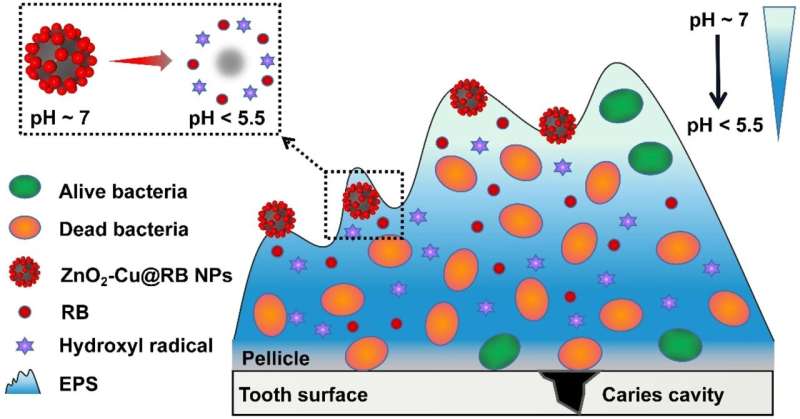Researchers propose new strategy for prevention and treatment of dental caries

One of the most common biofilm-related infections is dental caries which affects more than 60% of children and almost all adults around the world.
The pathogenic bacteria, Streptococcus mutans (S. mutans), induce cavities based on the formation of extracellular polysaccharides (EPS) and their survival in acidic environments. The plaque biofilm formed has the characteristics of water insolubility, retention, and low membrane permeability.
A research group led by Prof. Chen Zhuo from the Fujian Institute of Research on the Structure of Matter of the Chinese Academy of Sciences has developed a pH-responsive metal peroxide nanocomposite for chemodynamic therapy (CDT) by loading Rose Bengal (RB), an antibacterial agent, on copper-doped zinc peroxide nanoparticles (ZnO2-Cu NPs).
The study was published in Chemical Engineering Journal on May 26.
The researchers found that ZnO2-Cu@RB NPs could quickly produce sufficient H2O2 in an acidic biofilm environment. The divalent copper ions (Cu2+) were released and participated in a Fenton-like reaction to produce hydroxyl radicals. Therefore, the self-supplied Cu2+ and H2O2 greatly enhanced the efficacy of CDT.
They also revealed that ZnO2-Cu@RB NPs (at a concentration of 256 μg mL-1) killed more than 8.0 log10 of S. mutans embedded in the EPS-rich matrix.
“ZnO2-Cu@RB NPs effectively inhibited the production of acidic substances, the formation of biofilm, and the demineralization of apatite at low pH. Local application of ZnO2-Cu@RB NPs effectively inhibited the occurrence and severity of dental caries without harmful effects on the body,” said Prof. Chen.
Source: Read Full Article
